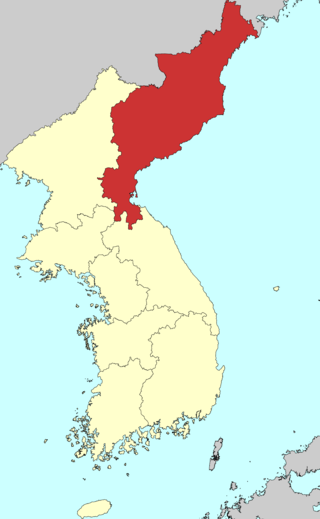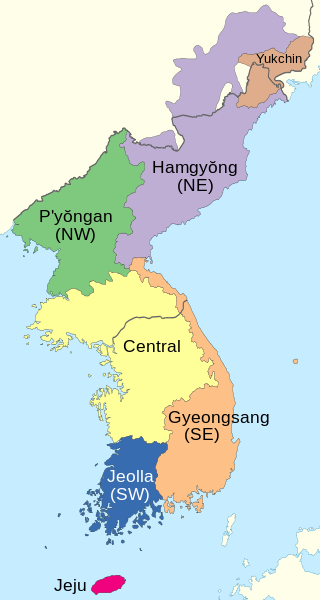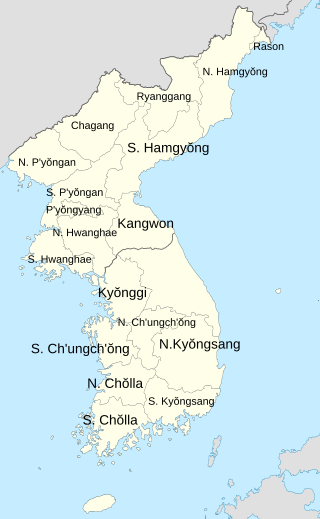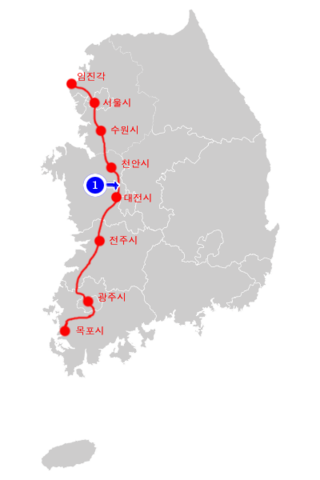
List of railway stations in North Korea. [1] Closed stations are not included.

List of railway stations in North Korea. [1] Closed stations are not included.
Korea has had administrative districts that can be considered provinces since the 7th century. These divisions were initially called ju in Unified Silla and Later Baekje, and there were nine in total. After Goryeo conquered these states in the 10th century, twelve divisions called mok were established, although they were reorganized into ten do in the 11th century.

Korea(n) Bay, sometimes West Korea(n) Bay, is a bight and the northern extension of the Yellow Sea, between the southeastern coastline of China's Liaoning Province and the western coastline of North Korea's North Pyongan, South Pyongan and South Hwanghae provinces. It is separated from the Bohai Sea by the Liaodong Peninsula, with Dalian's Lüshunkou District marking its western end, and westernmost tip of North Korea's Ryongyon County as its eastern end.

North Hwanghae Province is a province of North Korea. The province was formed in 1954 when the former Hwanghae Province was split into North and South Hwanghae. The provincial capital is Sariwon. The province is bordered by Pyongyang and South Pyongan to the north, Kangwon to the east, Kaesong Industrial Region and South Korea's Gyeonggi Province to the south, and South Hwanghae southwest. In 2003, Kaesong Directly Governed City became part of North Hwanghae as Kaepung County. Later on in 2019, it was promoted as Special City. Thus, it was separated from North Hwanghae.

South Pyongan Province is a province of North Korea. The province was formed in 1896 from the southern half of the former Pyongan Province, remained a province of Korea until 1945, then became a province of North Korea. Its capital is Pyongsong.

South Hamgyong Province is a province of North Korea. The province was formed in 1896 from the southern half of the former Hamgyong Province, remained a province of Korea until 1945, then became a province of North Korea. Its capital is Hamhung.

Pyongan Province was one of Eight Provinces of Korea during the Joseon Dynasty. Pyongan was located in the northwest of Korea. The provincial capital was Pyeongyang.

Hamgyong Province was one of the Eight Provinces of Korea during the Joseon Dynasty. Hamgyong was located in the northeast of Korea. The provincial capital was Hamhung.

Chagang Province is a province in North Korea; it is bordered by China's Jilin and Liaoning provinces to the north, Ryanggang and South Hamgyong to the east, South Pyongan to the south, and North Pyongan to the west. Chagang was formed in 1949, after being demarcated from North Pyongan. The provincial capital is Kanggye. Before 2019, Chagang was the only province of North Korea completely inaccessible to tourists, possibly due to weapons factories and nuclear weapon facilities located there. In 2019 the city of Manpo became accessible to tourists. In May 2018, the province became a "Special Songun Revolutionary Zone" in relations to concealing the nuclear weapon and weapon's factories within the province.

A number of Korean dialects are spoken on the Korean Peninsula. The peninsula is very mountainous and each dialect's "territory" corresponds closely to the natural boundaries between different geographical regions of Korea. Most of the dialects are named for one of the traditional Eight Provinces of Korea. Two are sufficiently distinct from the others to be considered separate languages, the Jeju and the Yukjin languages.

Kwanbuk, or Gwanbuk (Korean: 관북), is a region of Korea now comprising the northeast provinces of Ryanggang, North Hamgyong, South Hamgyong, and the Rajin-Sonbong Special Economic Zone. It borders the Kwansŏ region to the west and the Kwandong region to the east, and faces the Sea of Japan to the east.

Kwansŏ (Korean: 관서), or Gwanseo, is a region of Korea. It lies in the northwest of the Korean Peninsula, occupied by the North Korean provinces of North Pyongan, South Pyongan, and Chagang, as well as the cities of Pyongyang and Nampo.

Flooding in North Korea in July 2006 caused extensive damage and loss of life, although reports differ about its extent.

Chŏngp'yŏng County is a county in South Hamgyŏng province, North Korea. It borders South P'yŏngan province to the south, and the East Korea Bay to the east.

Provinces are the first-level division within North Korea. There are 9 provinces in North Korea: Chagang, North Hamgyong, South Hamgyong, North Hwanghae, South Hwanghae, Kangwon, North Pyongan, South Pyongan, and Ryanggang.
Korean regional cuisines are characterized by local specialties and distinctive styles within Korean cuisine. The divisions reflected historical boundaries of the provinces where these food and culinary traditions were preserved until modern times.

National Route 1(Korean: 국도 제1호선; RR: Gukdo Je Il Hoseon) is a national highway in South Korea. It connects Mokpo, South Jeolla Province with the city of Paju in Gyeonggi-do. Before the division of the Korean peninsula, the highway ran until Sinuiju, North P'yongan Province, in present-day North Korea.

The 2012 North Korean floods began in mid-July 2012 when Tropical Storm Khanun affected parts of the country, killing at least 88 people and leaving more than 62,000 people homeless. Torrential rains on 29 and 30 July 2012 worsened the situation, causing additional damage and casualties and forcing the government to request international assistance. Severe rainfall also affected the southern region of North Korea in August, killing at least six.
Hwanghae dialect is a dialect of Korean spoken in North Hwanghae Province, South Hwanghae Province in North Korea, as well as the islands of Baengnyeongdo, Yeonpyeongdo and Daecheongdo in Ongjin County in South Korea. It may also be spoken among former Korean War refugees in cities such as Incheon.
Unsong or variation, may refer to:
Kim Yol was a North Korean politician who served in various state and party positions in North Korea's early years.